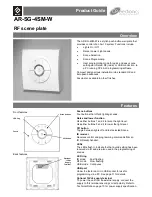
TMP91C824
91C824-180
2008-02-20
Figure 3.10.28
Receiver Mode (Example: Internal clock)
c. 8-bit
transmit/receive
mode
Set a control register to a transmit/receive mode and write data to SBI0DBR.
After the data has been written, set SBI0CR<SIOS> to 1 to start
transmitting/receiving. When data is transmitted, the data is output via the SO
pin, starting from the least significant bit (LSB) and synchronized with the
leading edge of the serial clock signal. When data is received, the data is input
via the SI pin on the trailing edge of the serial clock signal. 8-bit data is
transferred from the shift register to SBI0DBR and an INTSBI interrupt request
is generated. The interrupt service program reads the received data from the
data buffer register and writes the data which is to be transmitted. SBI0DBR is
used for both transmitting and receiving. Transmitted data should always be
written after received data has been read.
When an internal clock is used, the automatic wait function will be in effect
until the received data has been read and the next data has been written.
When an external clock is used, since the shift operation is synchronized with
the external clock, received data is read and transmitted data is written before a
new shift operation is executed. The maximum transfer speed when an external
clock is used is determined by the delay time between the time when an
interrupt request is generated and the time at which received data is read and
transmitted data is written.
When the transmit is started, after the SBI0SR<SIOF> goes 1 output from the
SO pin holds final bit of the last data until falling edge of the SCK.
Transmitting/receiving data ends when <SIOS> is cleared to 0 by the INTS2
interrupt service program or when SBI0CR1<SIOINH> is set to 1. When <SIOS>
is cleared to 0, received data is transferred to SBI0DBR in complete blocks. The
transmit/receive mode ends when the transfer is complete. In order to confirm
whether data is being transmitted/received properly by the program, set SBI0SR
to be sensed. <SIOF> is set to 0 when transmitting/receiving has been completed.
When <SIOINH> is set to 1, data transmitting/receiving stops. <SIOF> is then
cleared to 0.
Note: When the transfer mode is changed, the contents of SBI0DBR will be lost. If
the mode must be changed, conclude data transmitting/receiving by clearing
<SIOS> to 0, read the last data, then change the transfer mode.
SBI0DBR
INTSBI interrupt
request
<SIOS>
<SIOF>
<SEF>
SCK pin (Output)
SI pin
b
Clear <SIOS>
a
a
0
a
1
a
2
a
3
a
4
a
5
a
6
a
7
b
0
b
1
b
2
b
3
b
4
b
5
b
6
b
7
Read receiver data
Read receiver data
















































